
A PERFECT DAY
 |
Click on the collage to hear another version of A Perfect Day |
| |
| |
| The Regent's Canal, 1904-2011 |
| |
I used to love going on the little red bus. It had a certain resemblance to the old coaches that we took to go to the seaside before Grey Green introduced their more luxurious line complete with a sliding sun roof, which could be opened to increase ventilation on hot days. The Crockle Bus had large windows at the front of the bus and had the driver’s cabin on the right. I remember the windscreen wiper, as it moved very fast, although it never seemed able to win the battle with the rain. Entrance to the bus was at the front and I seem to remember that we had to climb up a few steps to get on. I don’t remember the seats, but I believe that passengers had to step up from a central gangway to sit down.
Bus tickets were sold by a conductor. All buses at that time, whether single or double decker had both a driver and a conductor. There were no one-operator vehicles at that time. In those days, most London Transport bus drivers and conductors were men. It was a rare sight to see a woman bus conductor, but none were drivers. Fares depended on the distance a passenger wanted to go. The conductor walked up and down the gangway asking Anymore fares, please or fares please, as they looked around for those holding up coins for them to take. He carried a ticket rack either in his hand or under his arm which held an array of different coloured tickets. Each coloured ticket represented a different fare. Passengers would either tell the driver the cost of their journey while handing him the money or else they told him their destination and he would inform them of the cost. Next the conductor plucked the correct ticket from his rack and placed it in his Bell Punch and then punched a hole in it by depressing a small lever on the device. The Bell Punch was a small device that was held in place across the abdomen by a series of leather straps. It was called a Bell Punch, as Bell was the name of the company that made it and not after the sound it made when punched. The ticket was now passed to the passenger who was required to hold it and be ready to show it to an inspector should one get on the bus to check that everything was in order. The conductor also carried across his shoulder a large leather Cash Bag with several open compartments to hold the money collected. In those days, London Transport staff members were smartly dressed in well-maintained dark blue uniforms in winter together with ties. In summer months, they were allowed to wear a grey cotton company jacket. |
| |
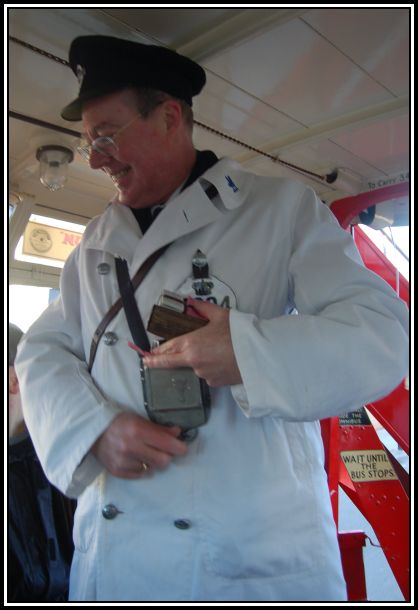 |
| I would like to thank Barry LeJeune for providing this photograph |
| |
| Since I did not take a Crockle Bus with any regularity, it was always exciting to take a trip on one. However, it was not only the bus that I enjoyed, but also the journey. The journey between London Fields and the Ridley Road Market may be divided into two parts and it was the first part of the route from London Fields to Queensbridge Road that I found special. |
| |
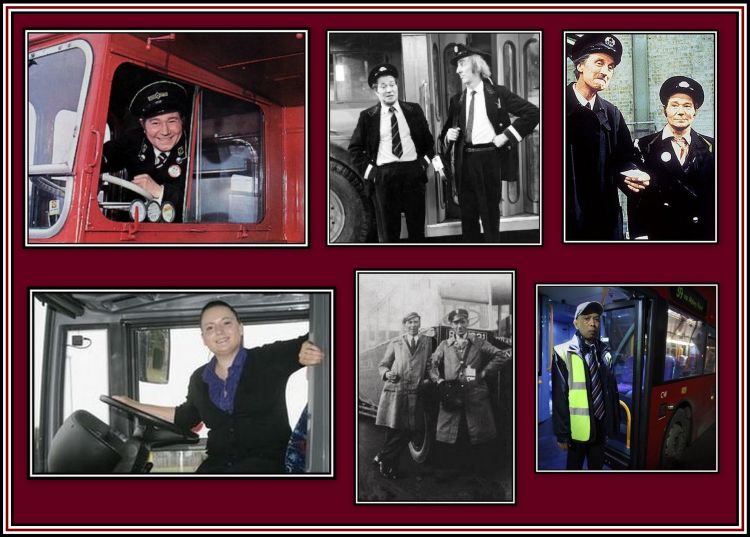 |
On the Buses
Click on the collage to see a video clip. |
| |
I suspect that I am the victim of an over active imagination and possibly guilty of a number of misconceptions when it comes to my memories of the journey to the Ridley Road Market. I will explain this a little later in the story. At this time, I will only relate how this magical journey is remembered in my memory. But before I do, I need to introduce certain things to help explain why this journey was so special to me.
London sits astride the River Thames and was once Britain’s major port. The river and the Port of London Authority Docks were not far from where I lived as a child. Since both my mother and father enjoyed the river and the docks, we would often take walks there on Sunday evenings during the summer months. My mother had worked on British Railways during the Second World War and spent those years driving a large wagon pulled by a team of huge Belgian horses. She and her horses and cart were based at Aldgate, adjacent to the bus terminus. From here, each day she drove the team down to the docks and loaded up the wagon with goods for delivery in the City of London. As a result, she became familiar with the docks and the City and developed a fondness for both areas as well as for the river and the great ships that docked there from all over the world. |
| |
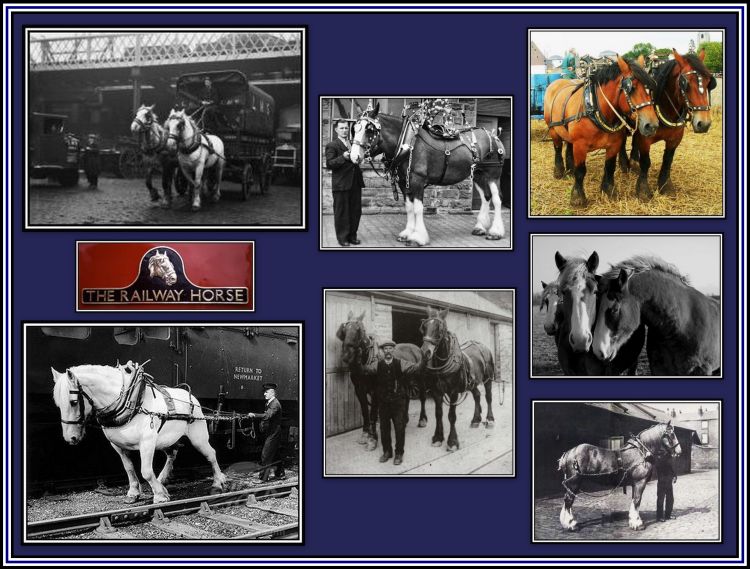 |
| |
| My father also enjoyed going to the river and to the docks. He especially liked going to the Tower of London and never tired of walking by the river there. He knew many stories about the Tower and liked to linger at Traitors Gate where he would tell me blood chilling stories about the people who passed through the gate and how their heads were severed from their bodies by either axe or sword. My father was a great story-teller when he chose and would act out the plot. I was always totally mesmerized by his stories and quickly transported back to the times where his tales were set. As fascinating as I found his tales, and believe me, I did, I was perhaps a bit too young to hear such ghoulish stories and occasionally suffered nightmares as a result. Naturally this did not please my mother. |
| |
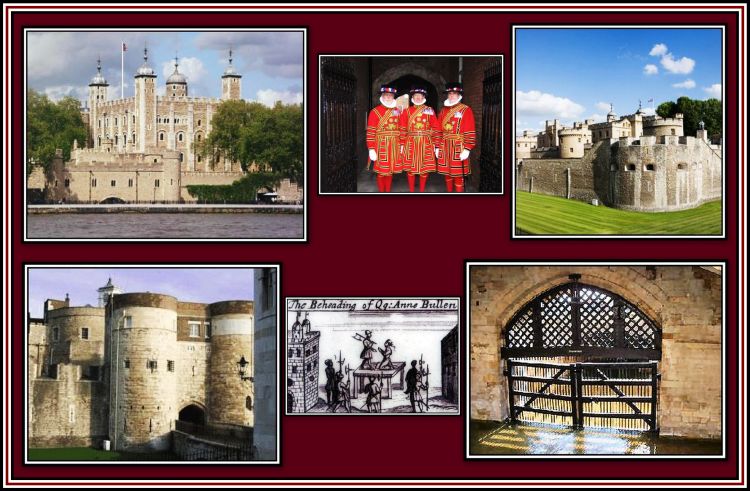 |
| |
| My father really enjoyed walking across the bridges over the Thames. I remember that when the new Waterloo Bridge was finally completed, he could not wait to walk over it and insisted that we dress in our finest clothes for this grand occasion. He was taken with the bridge and we were not allowed to sit down until after we had walked across it several times and had inspected both its north and south bank bases. I cannot see Waterloo Bridge today without thinking of that first visit and how tried I had been at the end of the visit. |
| |
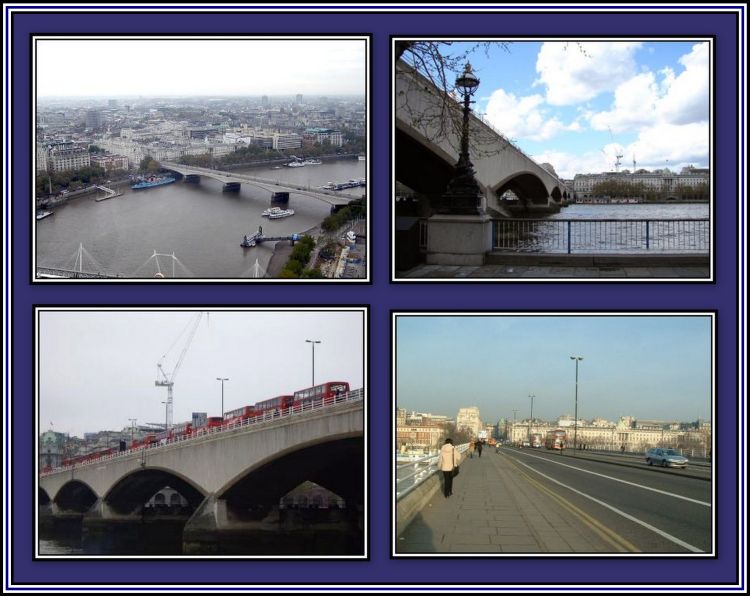 |
Present Day Waterloo Bridge
Click on the collage to hear a musical clip |
| |
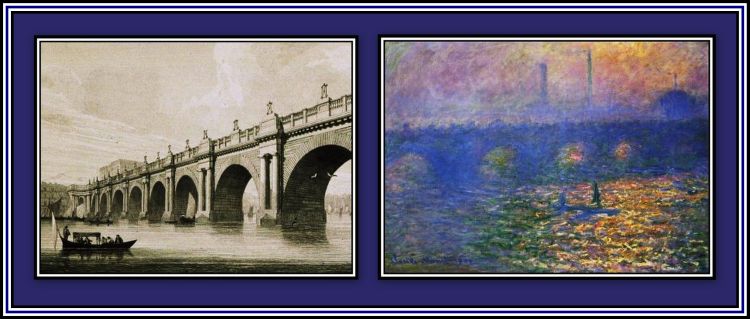 |
Waterloo Bridge, 1814 & the Painting by Monet |
| |
| As fond as my father was of all the bridges across the Thames, he was especially fond of Tower Bridge and loved walking across it. And so it is not surprising that I grew up liking the Tower and the City of London, as well as the river, its docks, ships and bridges, and especially Tower Bridge. One of my fondest memories of our walks across Tower Bridge was when we would straddle the bascules so that one foot rested on the northern bascule and the other on the southern. When heavy vehicles rumbled across the bridge at high speed, I would experience a strange and exhilarating feeling as the bascules moved out of unison. At my young age, I was fearful that the bridge would not support the traffic and us, yet I could not resist standing at what I felt was a precarious position. My father, being a big kid at heart, loved doing this and would laugh heartily, as the traffic loudly rumbled over the bridge and set the bascules in motion. Naturally my mother thought such activity dangerous and would not risk it. |
| |
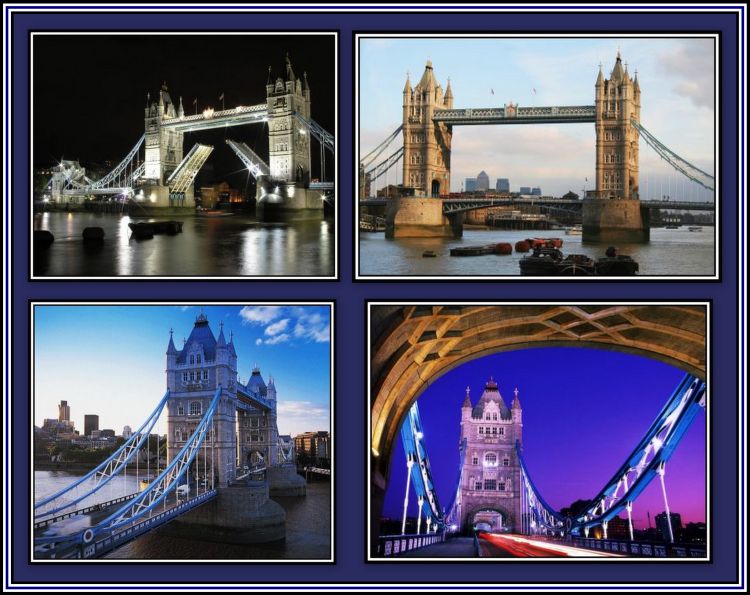 |
| |
As a child, I found our ability to cross over water to be a remarkable feat, somewhat akin to magic. Naturally, I knew nothing of engineering and stresses and strains and so on at that time. Since learning about what is actually required to build a bridge and have it not collapse, I find that I am even more enamored of their construction.
On its way to Queensbridge Road, the Crockle Bus crosses the Regent’s Canal. Naturally I also liked canals. Canals were once vital to Britain during the early years of The Industrial Revolution and in a short period of time a canal network linking all major cities and industrial areas was in place to transport manufactured goods and raw materials to where they were needed. This canal was built just north of central London and was dug to link the Grand Union Canal at Little Venice in Maida Vale with the Paddington Basin in the west and with Limehouse and the Thames in the east. Building began on the canal at Paddington in 1812 and the first section from here to Camden Town was opened in 1816. Building was finally completed in 1820 at Limehouse where the canal enters the Thames. The canal was once a thriving hub of activity with barges carrying coal and other goods in both directions between the docks and sites of industry as well as to both Kings Cross and St. Pancras Stations. With the subsequent development of rail and road systems, the use of canals as a pathway for moving goods declined and today they are mostly used for pleasure craft and for the mooring of house-barges. |
| |
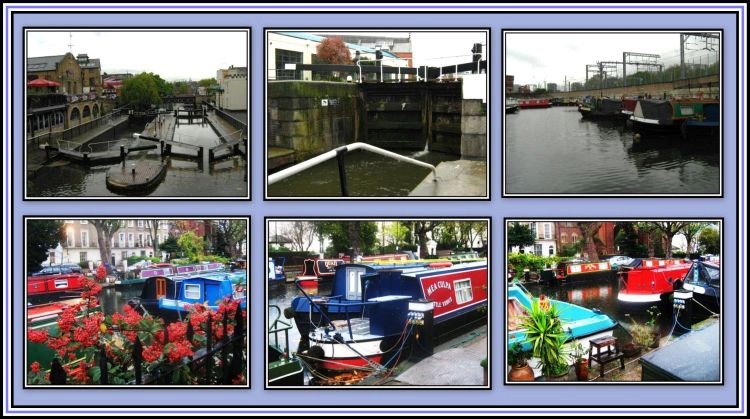 |
| The Regent's Canal |
| |
| As a child, I was not aware that the canals that I saw in the East End were all part of the Regent’s Canal. I always believed that the canals that I crossed over were unique entities and had no idea that they were one-and-the-same. According to me, there was a canal that crossed the southern end of Broadway at London Fields, a second that ran under the bridge over Roman Road close to Globe Town in Bethnal Green and a third that passed by Victoria Park. One of my favourite things to do as a small child was to cross the canal at Roman Road. I especially enjoyed doing this by bus for two reasons: firstly there was a long run-up to the bridge, which allowed you to tower over the canal especially if you were sitting on the bus’ upper deck, and secondly, if you were lucky, it was often possible to see a horse pulling a barge along the canal. Believe it or not, I loved to see this. I was always amazed that a horse could pull a heavy load, such as a barge, through the water. Obviously at that age, I had no concept of physics or the capabilities of the horse. Seeing such a site put me in a good mood and allowed me to tolerate going shopping at the Roman Road Market. I genuinely believed that any suffrage I was compelled to endure had been more than compensated for by the site of the horse going about its work. |
| |
 |
The Regent's Canal at London Fields |
| |
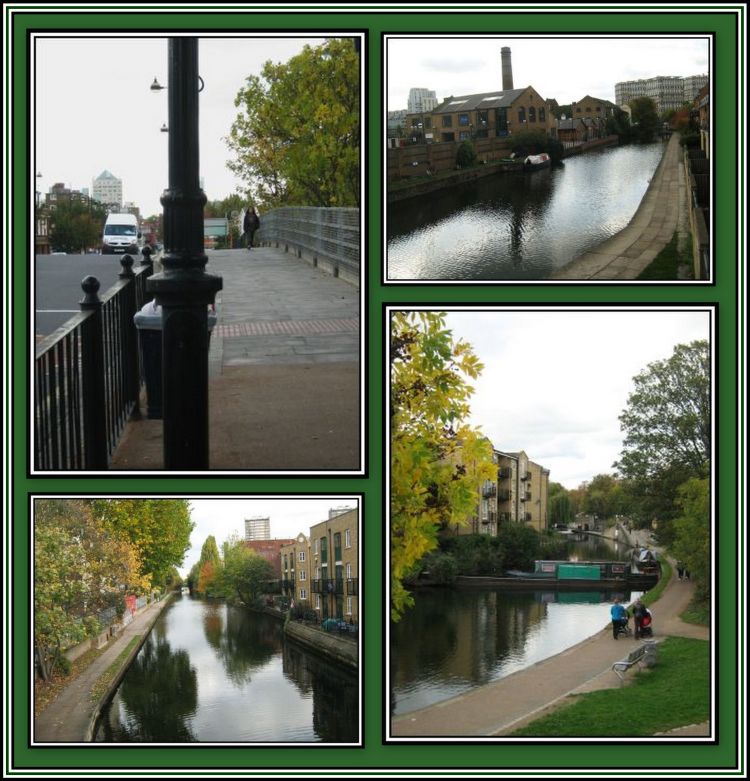 |
The Regent's Canal close to the Roman Road, Bethnal Green
Top left: The Roman Road Bridge over the canal |
| |
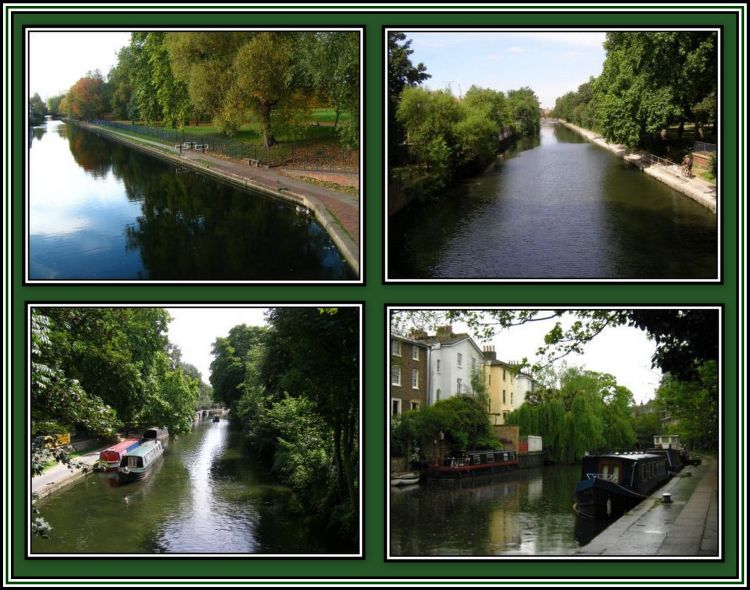 |
The Regent's Canal at Victoria Park |
| |
I remember that whenever we took the Crockle Bus to the Ridley Road Market, I had to sit on the left-hand side of the bus so that I could better see the four canals that we passed over. The journey from London Fields to Queensbridge Road was like being on a racetrack. The road twisted and turned as it rounded the curves and passed over the canals. Passengers had to hold tight as the bus zigged first in one direction and then zagged in another. I was thrilled when we came to the little bridges that took us over the canals, as I always lived in hope that I would catch a glimpse of a horse at work. Although I cannot remember ever seeing one during those journeys, the lack of a sighting never managed to spoil my visits to the market, as there were remarkable treats to be had after arrival. |
| |
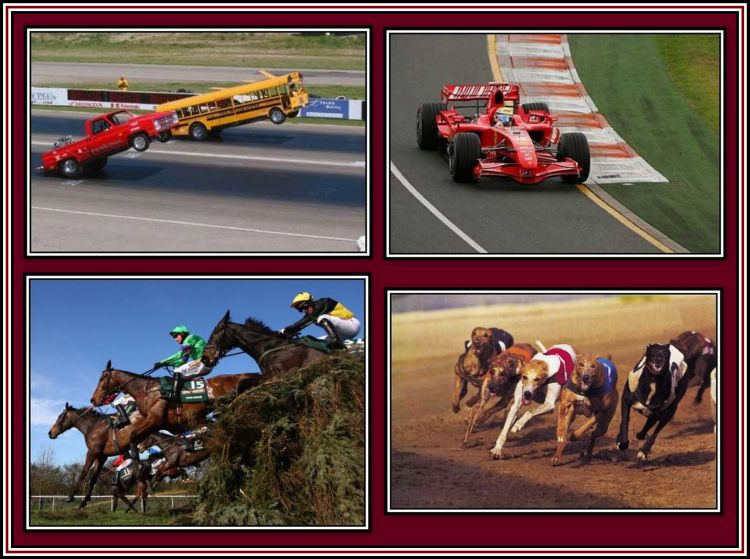 |
Racing 'Round the Track |
| |
For most of the route, we passed through a residential area where the narrow road was lined with small Victorian houses that were in poor condition. Once the bus crossed Queensbridge Road, the route was not as interesting and I could not wait to arrive at our destination, which was at the backend of the Ridley Road Market. |
| |
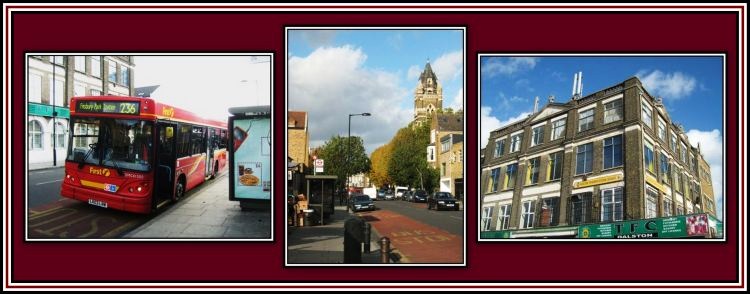 |
| The Bus Stop at the foot of Ridley Road |
| |
|
What I find most interesting about Route 236, is its use almost exclusively of back roads. Today buses take back roads to get closer to peoples’ homes, but in 1926 when the route was introduced, back roads were used because the Metropolitan Police, who controlled bus routes at the time, thought there were too many buses on the roads and sought Parliamentary approval to control the number of buses on designated streets. This made it much harder for the independent operators (or pirates, as they were called) to find new routes, and the 236 (263 as it then was) is the best known example of their ingenuity.
On the subject of women on the buses, the wartime clippies are a well known part of the way women stepped in when the men were away, but what is less known is that they were summarily fired when the men came back, so the men could be given the jobs. It was a few years later that London Transport started suffering a staff shortage and changed their minds and began to rehire women.
The Bell Punch machine had a receptacle, which collected the coloured discs cut from the tickets. These discs were checked at night to confirm the value of tickets issued. That is one reason why the tickets were different colours.
Peter Osborn |
| |
|
|
|
|
|
|